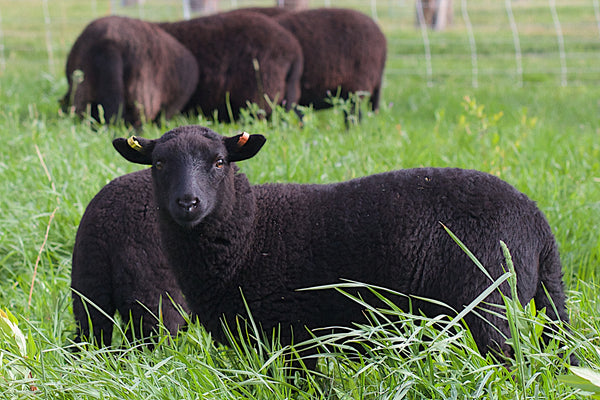Know Your Fiber: Black Welsh Mountain Sheep
Posted on February 01 2019

Baa, baa black sheep, have you any wool? The Black Welsh Mountain Sheep certainly does! A member of the Welsh Mountain Sheep breed, this hardy sheep is one of the few sheep out there that are bred specifically for their black wool.
Welsh Mountain Sheep (Defaid) are an old heritage breed that have been kept in Wales for centuries. Their hardiness and their ability to easily lamb and take care of their young makes them the ideal sheep for the Welsh hills and mountains. Typically, shepherds leave the sheep in the Welsh hills and mountains to forage, only rounding them up for lambing or shearing a few times a year. The first recorded incidence of Welsh Mountain Sheep is from the Middle Ages, but these sheep are likely even older than that. The Black Welsh Mountain Sheep (Defaid Mynydd Duon) in particular can trace its genotype all the way back to early Scandinavia, suggesting that perhaps its ancestors include sheep brought over to Wales by early Vikings.
Monks in Wales during the Middle Ages raised Welsh Mountain Sheep, as did the larger Welsh population. These sheep were highly prized for their quality of meat, and the wool was used for clothing. The wool from the Black Welsh Mounting Sheep in the monks’ herds was used to make the cloth for monks’ habits. The particular color of wool they used from Black Welsh Mountain Sheep was known as cochddu, Welsh for reddish-brown. How does wool from a black sheep become reddish-brown, you ask? Well, unless black sheep wear coats over their wool, known as being rugged or coated, just being out in the sun all day will lighten the tips of their wool coat to brown or in the case of cochddu, a reddish-brown color. These monks may have worn cochddu wool as a sign of poverty – white wool sold for more than any other color of wool. White wool after all, can be dyed any color. Black, brown and gray wool? Not so much.
As wool and fabric production became more and more industrialized, the demand for white wool kept increasing. Black sheep were typically seen as an unfortunate chance occurrence that shepherds simply had to put up with. These less valuable sheep led to the still common phrase, “the black sheep of the family” to indicate family members that, well, diverged from what was considered normal and desirable family behavior.
Although early shepherds may have only had limited success in reducing the number of their black sheep, this was about to change during the 1800s. Gregor Mendel discovered the fundamental laws of inheritance during 1850-1860, establishing some of the basic ideas of how dominant and recessive traits were passed on. Soon articles were being written and lectures were being presented to societies on how to selectively breed for more sheep with the white wool that was so desired by the cloth manufacturing industry. Shepherds began to apply this newly discovered scientific idea to their flocks so as to gradually weed out sheep with unwanted colorations or other traits.
Very interestingly, the exact period during which many shepherds were using these early scientific methods of breeding to make their flocks whiter, a groups of Welsh shepherds decided to use that same science to develop an all-black breed of sheep. Was it contrariness? A desire to preserve a color that they were worried would die out? Maybe. But more likely is was due to the popularity of whole, wooly sheepskins as a decorative and functional household item. Looking for something unique, it is likely that the public latched onto the beauty of the cochddu wool that was produced by Black Welsh Mountain Sheep. There is evidence that cochddu wool from the Black Welsh Mountain Sheep was in relatively high demand by mid-1800s merchants. This demand, plus the Black Welsh Mountain Sheep’s reputation for flavorful mutton, likely saved help save this unique wool from disappearing.
As time went on, Welsh breeders continued to develop and refine these black sheep as a dual-breed – that is, a sheep that is used for both meat and wool. The first Black Welsh Mount Sheep breeders’ association from formed in 1920, establishing Black Welsh Mountain Sheep as a unique breed raised for their black coats. These sheep were first imported into North America by Thomas Wyman in 1972; the first U.S. breed registry was established in 1990. There are just around 1600 Black Welsh Mountain sheep in North America today, with an additional 8500 in the U.K. and Ireland. This makes the wool from these sheep relatively uncommon.
Today, most Black Welsh Mountain Sheep are rugged to preserve the color their dark black wool, which is highly prized by spinners. That said, is isn’t uncommon to find some sun bleached reddish-brown tips in this wool top, which can lend a lovely overtone to the wool. The wool from these sheep is about 2-4 inches long (5-10cm), and at 24-36 microns is classified as a medium to coarse wool – this makes it perfect for outerwear and other projects that require durable wool. Interested in spinning up some of this heritage breed for yourself? Check out the Black Welsh Top in our shop or online!

Follow US